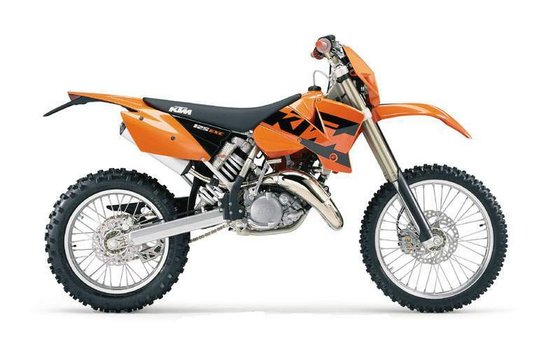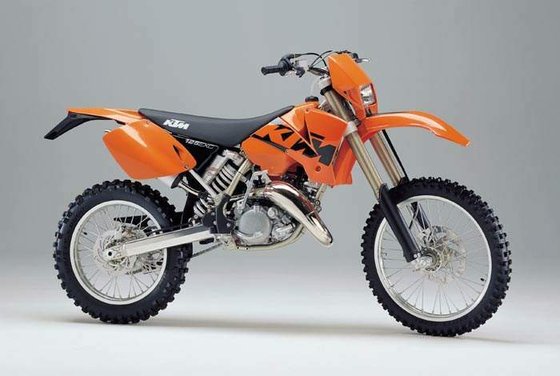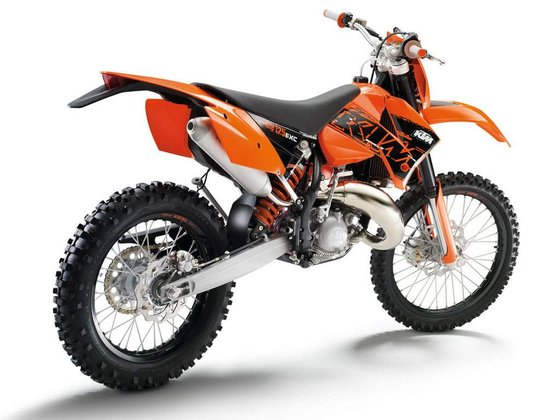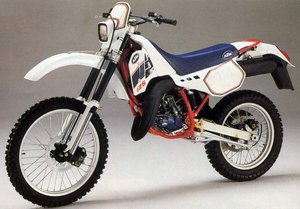KTM 125 EXC (2004-2006): The Underestimated Enduro Gem

Introduction
The KTM 125 EXC, produced between 2004 and 2006, remains a cult favorite among enduro enthusiasts. Designed as a lightweight, agile two-stroke for tight trails and technical terrain, this Austrian machine defies expectations with its blend of precision engineering and raw fun. While it never officially reached U.S. shores, its reputation in Europe and Australia as a "pocket rocket" enduro bike is well-deserved. After spending a day thrashing this orange devil through muddy creek beds and rocky ascents, it’s clear why riders still seek out this generation for both competition and weekend adventures.

Engine Performance: Two-Stroke Simplicity Meets Precision
At the heart of the 125 EXC lies a 124.8cc liquid-cooled two-stroke engine, producing 15 hp at 7,500 rpm. The Keihin PWK 36-38mm carburetor (varies by year) delivers a crisp throttle response, while the Kokusan digital ignition ensures reliable spark even when coated in mud. With an 11:1 compression ratio and a 6-speed gearbox, this engine thrives in high-RPM environments.
Power Delivery:
- Low-end: Modest grunt below 6,000 rpm—enough to crawl over logs but demands clutch finesse.
- Mid-range: A smooth surge from 6,500 rpm onward, avoiding the abrupt "hit" of older two-strokes.
- Top-end: Screams willingly to its 9,500 rpm limiter, though power flattens past 8,500 rpm.
The hydraulic clutch (a rarity in 125cc bikes of this era) is buttery light, allowing riders to fan the lever endlessly without fatigue. Mix oil at 1:40 ratio, and this engine will reward you with minimal fouling—even when idling through technical sections.

Handling: Lightweight Agility Meets WP Wizardry
KTM’s Chromium molybdenum frame and WP suspension combo make the 125 EXC feel like an extension of your body. At 98.6–104 kg (217–229 lbs) dry, it’s a featherweight compared to modern four-strokes.
Suspension Setup:
- Front: WP USD 48mm forks with 300mm (11.8") of travel soak up rocks and roots without deflection.
- Rear: WP PDS shock offers 335mm (13.2") of progressive travel, staying composed during hard landings.
The 1471mm (57.9") wheelbase and 27° rake angle create a razor-sharp turning radius. On tight singletrack, the bike flicks between trees with telepathic responsiveness. However, the 925mm (36.4") seat height may intimidate shorter riders—consider a lowering kit or shaved seat.
Braking is handled by a 260mm front/220mm rear disc combo. While lacking initial bite compared to modern setups, they offer excellent modulation for slippery descents.
Competition: How It Stacks Up
The 125 EXC’s closest rivals in the 2000s enduro scene included:
1. Husqvarna WR125 (2004-2006)
- Pros: Stronger low-end torque, plush Sachs suspension.
- Cons: 7kg heavier, cable-operated clutch, less precise handling.
- Verdict: Better for slower technical terrain, but the KTM dominates in agility.
2. Yamaha WR125R (2004-2006)
- Pros: Fuel-injected four-stroke reliability, lower seat height.
- Cons: 20% less power, 15kg heavier, dull throttle response.
- Verdict: A beginner-friendly alternative but lacks the KTM’s excitement.
3. GasGas EC125 (2004-2006)
- Pros: Trials-inspired chassis, superior low-RPM tractability.
- Cons: Frequent maintenance intervals, parts scarcity.
- Verdict: A niche choice for trials/enduro hybrids; KTM wins for all-round usability.
The 125 EXC’s secret weapon? Momentum. While bigger bikes like the KTM 200 EXC or Yamaha WR450F rely on brute force, this 125cc machine rewards riders who maintain corner speed and plan shifts meticulously.
Maintenance: Keeping the Orange Beast Alive
As a MOTOPARTS.store journalist, I’ve seen these bikes thrive—or die—based on three key areas:
1. Engine Longevity
- Spark Plugs: Replace NGK BR9EIX every 20 hours. Carry spares—two-strokes eat plugs during wet rides.
- Piston Rings: Inspect every 50 hours; replace at 100 hours. Use a bore scope to check cylinder scoring.
- Carburetor: Clean the Keihin PWK every 30 hours. Upgrade to a JD Jet Kit for altitude adjustments.
2. Suspension TLC
- Forks: Change 5W oil annually. Install SKF seals to prevent bush wear.
- Shock: Rebuild the WP PDS every 100 hours. Check nitrogen pressure (130–150 PSI).
3. Critical Upgrades
- Clutch: Swap OEM fibers for Rekluse TorqueDrive plates if you’re a clutch-abuser.
- Exhaust: FMF Fatty pipe adds mid-range punch without sacrificing top-end.
- Gearing: Drop to 12/50 sprockets (from stock 13/50) for hill climbs.
Pro Tip: Always carry a 6mm Allen key—the rear axle pinch bolts love to loosen mid-ride!
Conclusion: The Joy of Riding a Scalpel
The 2004–2006 KTM 125 EXC isn’t just a bike; it’s a masterclass in momentum-based riding. It teaches you to read terrain three corners ahead, to dance on the pegs, and to squeeze every ounce of performance from 124.8cc. While modern four-strokes have eclipsed two-strokes in showrooms, this generation remains a beacon of analog thrill.
For riders under 80kg (176 lbs), it’s a revelation. For everyone else? Let’s just say there’s no better way to humble your ego—and have a blast doing it.
Looking to upgrade your KTM 125 EXC? Explore MOTOPARTS.store’s curated selection of enduro-specific tires, performance exhausts, and suspension kits to unleash this bike’s full potential.
Specifications sheet
| Engine | |
|---|---|
| Stroke: | Two-stroke |
| Ignition: | Kokusan digital 2K-3 |
| Max power: | 11 kW | 15.0 hp |
| Fuel system: | Keihin PWK 38 AG carburetor (2004-2005); Keihin PWK 36 S AG carburetor (2006) |
| Max power @: | 7500 rpm |
| Displacement: | 125 ccm |
| Bore x stroke: | 54.0 x 54.5 mm (2.1 x 2.1 in) |
| Configuration: | Single |
| Cooling system: | Liquid |
| Compression ratio: | 12.5:1 |
| Lubrication system: | Premix 1:40 |
| Number of cylinders: | 1 |
| Dimensions | |
|---|---|
| Wheelbase: | 1471 mm (57.9 in) |
| Dry weight: | 99 |
| Seat height: | 925 mm (36.4 in) adjustable to 675 mm (26.6 in) |
| Ground clearance: | 390 mm (15.4 in) |
| Fuel tank capacity: | 9.5 L (2.5 US gal) |
| Drivetrain | |
|---|---|
| Clutch: | Hydraulically operated wet multi-disc |
| Final drive: | chain |
| Transmission: | 6-speed |
| Rear sprocket: | 50 |
| Front sprocket: | 13 |
| Maintenance | |
|---|---|
| Brake fluid: | DOT 4 |
| Spark plugs: | NGK BR9EIX |
| Coolant capacity: | 1.2 |
| Transmission oil: | SAE 20W-40 |
| Transmission oil capacity: | 0.7 |
| Chain maintenance interval: | Clean/lube every 500 km (310 mi) |
| Front sprocket replacement interval: | Every 15,000 km (9,320 mi) |
| Operational | |
|---|---|
| Starter system: | Kick |
| Maximum payload: | 150 kg (330 lbs) |
| Fuel octane recommendation: | 95 RON (91 AKI) |
| Recommended service interval: | Every 30 hours of operation |
| Chassis and Suspension | |
|---|---|
| Rake: | 27° |
| Frame: | Chromium molybdenum central double-cradle (2006); Chromium molybdenum (2004-2005) |
| Trail: | 116 mm (4.6 in) |
| Rear tire: | 120/90-18 |
| Front tire: | 90/90-21 |
| Rear brakes: | Single 220 mm disc, 1-piston caliper |
| Front brakes: | Single 260 mm disc, 2-piston caliper |
| Rear suspension: | WP-PDS monoshock (335 mm / 13.2 in travel) |
| Front suspension: | WP-USD 48 mm inverted fork (300 mm / 11.8 in travel) |



















